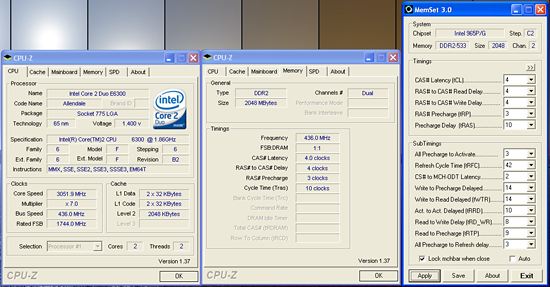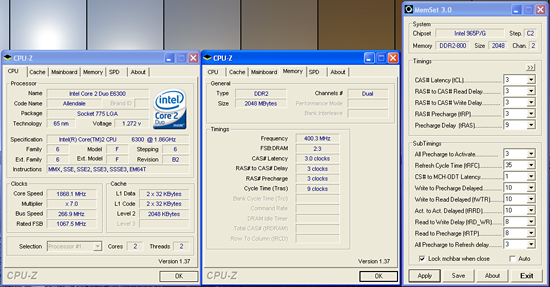Intel P965: Mid-Range Performance Sector Roundup
by Gary Key on October 20, 2006 9:00 PM EST- Posted in
- Motherboards
Abit AB9-Pro: Overclocking
FSB Overclocking Results
Our E6300 posted very good results when compared to our earlier overclocking test results that resulted in a maximum FSB speed of 366. However, the 7x436FSB level is the lowest of our test group today and does not match up to the promise of this board's performance. We also have an issue with our CPU requiring 1.4375V on this board to reach a stable 3.05GHz. We normally only require 1.40V in order to reach this level and noticed the board would not boot without an increase to 1.4375V although it was rock stable at this setting. Vdroop averaged around .02V to .03V during overclocking and heavy system loads. Our memory is usually very stable up to DDR2-900 at 4-3-3-10 settings but required slightly looser timings on this board. Although the overclocking results are not as high as our other boards, the ability to now run up to 436FSB in a stable manner is fine for the majority of people who want to overclock.
Memory Stress Testing
Memory stress tests look at the ability of the Abit AB9-Pro to operate at the official DDR2-800 memory frequency at the best performing memory timings our GEIL PC2-6400 can achieve on this board.
The Abit AB9-Pro was very stable with 2 DDR2 modules in Dual-Channel mode at the settings of 3-3-3-9 at 2.2V with the 1.4 and above BIOS. By increasing the voltage to 2.25V we could run at 3-3-3-6 timings although there were not any real performance improvements unless we utilized MemSet to change other latency settings.
We had to change our timings to 3-4-3-10 from 3-3-3-9 when installing two additional modules. We were able to keep our voltage set to 2.20V at this setting. We were able to maintain these settings up to a 7x405FSB, DDR2-810, setting with 2.30V. Our maximum overclock with four DIMMs installed was 7x418FSB, DDR2-836 4-4-3-12, with the memory set at 2.30V. Once again, we had to use BIOS 1.4 or higher in order for these settings to work.
In fact, on the first two BIOS releases this particular memory would not even boot when installed in this board. The memory itself is designed to run at 2.0V or higher depending upon the latencies selected. GEIL actually rates this memory at 2.4V for 3-4-3-8 operation at DDR2-800 although we have not required voltages above 2.2V at this setting.
FSB Overclocking Results
| Abit AB9-Pro Overclocking Testbed |
|
| Processor: | Intel Core 2 Duo E6300 Dual Core, 1.86GHz, 2MB Unified Cache 1066FSB, 7x Multiplier |
| CPU Voltage: | 1.4375V (default 1.3250V) |
| Cooling: | Scythe Infinity Air Cooling |
| Power Supply: | OCZ GameXStream 700W |
| Memory: | Geil PC2-6400 800MHz Plus (2x1GB- GX22GB6400PDC) (Micron Memory Chips) |
| Video Cards: | 1 x MSI X1950XTX |
| Hard Drive: | Seagate 320GB 7200RPM SATA2 16MB Buffer |
| Case: | Cooler Master CM Stacker 830 |
| Maximum CPU OC: (Standard Ratio) |
436x7 (4-4-4-12, 1:1, 2.3V) 3052MHz (+64%) |
| . | |
 |
| Click to enlarge |
Our E6300 posted very good results when compared to our earlier overclocking test results that resulted in a maximum FSB speed of 366. However, the 7x436FSB level is the lowest of our test group today and does not match up to the promise of this board's performance. We also have an issue with our CPU requiring 1.4375V on this board to reach a stable 3.05GHz. We normally only require 1.40V in order to reach this level and noticed the board would not boot without an increase to 1.4375V although it was rock stable at this setting. Vdroop averaged around .02V to .03V during overclocking and heavy system loads. Our memory is usually very stable up to DDR2-900 at 4-3-3-10 settings but required slightly looser timings on this board. Although the overclocking results are not as high as our other boards, the ability to now run up to 436FSB in a stable manner is fine for the majority of people who want to overclock.
Memory Stress Testing
 |
| Click to enlarge |
Memory stress tests look at the ability of the Abit AB9-Pro to operate at the official DDR2-800 memory frequency at the best performing memory timings our GEIL PC2-6400 can achieve on this board.
| Abit AB9-Pro Stable DDR2-800 Timings - 2 DIMMs (2/4 slots populated - 1 Dual-Channel Bank) |
|
| Clock Speed: | 800MHz |
| CAS Latency: | 3 |
| RAS to CAS Delay: | 3 |
| RAS Precharge: | 3 |
| RAS Cycle Time: | 9 |
| Voltage: | 2.20V |
The Abit AB9-Pro was very stable with 2 DDR2 modules in Dual-Channel mode at the settings of 3-3-3-9 at 2.2V with the 1.4 and above BIOS. By increasing the voltage to 2.25V we could run at 3-3-3-6 timings although there were not any real performance improvements unless we utilized MemSet to change other latency settings.
| Abit AB9-Pro Stable DDR2-800 Timings - 4 DIMMs (4/4 slots populated - 2 Dual-Channel Bank) |
|
| Clock Speed: | 800MHz |
| CAS Latency: | 3 |
| RAS to CAS Delay: | 4 |
| RAS Precharge: | 3 |
| RAS Cycle Time: | 10 |
| Voltage: | 2.20V |
We had to change our timings to 3-4-3-10 from 3-3-3-9 when installing two additional modules. We were able to keep our voltage set to 2.20V at this setting. We were able to maintain these settings up to a 7x405FSB, DDR2-810, setting with 2.30V. Our maximum overclock with four DIMMs installed was 7x418FSB, DDR2-836 4-4-3-12, with the memory set at 2.30V. Once again, we had to use BIOS 1.4 or higher in order for these settings to work.
In fact, on the first two BIOS releases this particular memory would not even boot when installed in this board. The memory itself is designed to run at 2.0V or higher depending upon the latencies selected. GEIL actually rates this memory at 2.4V for 3-4-3-8 operation at DDR2-800 although we have not required voltages above 2.2V at this setting.










62 Comments
View All Comments
zjohnr - Tuesday, November 7, 2006 - link
In all the features tables for the motherboards in this article the PCI slots are listed as being PCI v2.3. However, looking at the pictures for the boards, the slots have PCI v2.2 keying. I think the entry in the features tables is wrong. (Is it?)Patsoe - Saturday, October 28, 2006 - link
Seeing all the trouble with the P965 - especially with the non-intel p-ata controller and with the ich8r - I'd be inclined to get a Core2-ready i945P board with ICH7R instead. Would that be a sane idea?BadThad - Tuesday, October 24, 2006 - link
Is the v1.02G Asus P5B-E using all solid capacitors? I read a press release stating that Asus was releasing the "P4B-E Plus" version with all solid caps. Rumor says the "Plus" version will not be sold in the USA.....arrgggggg. Tell me that's not true. I want the solid caps for long-term reliability. I'm wondering if our "Plus" is actually the v1.02G?Thanks
Gary Key - Tuesday, October 24, 2006 - link
The 1.01G and 1.02G boards are exactly the same except for a PLL controller. Asus stills states the P5B-Plus will not be imported into the States but you never know.keithke - Monday, October 23, 2006 - link
I was interested to hear you used this Scythe Infinity Air Cooler as I was going to do the same. Were there any issues with the Northbridge heatsink sitting so close? Or did it just plop right in with no spacing issues?Thx
Keith
Gary Key - Tuesday, October 24, 2006 - link
No issues with the Inifinity on all four corners. It is a close fit but it works fine with the enclosed fan.SniperWulf - Monday, October 23, 2006 - link
Hey guys,Did you have any strange anomolies with the X-fi on the DS3 while overclocked? When I was using that board with the F6 bios, I'd have to reboot like 3-4 times before windows would properly detect it. I eventually grew tired of it and bought a P5B-D so I haven't had a chance to try F7 with it.
Gary Key - Monday, October 23, 2006 - link
I did not have any issues with the X-FI on the DS3 when it was overclocked. The F5 and F6 BIOS releases were not X-FI friendly where F4 was perfect. F7 is working for some and not others, I did not have an issue with it. F8 will fix it for good.schlumpfi106 - Monday, October 23, 2006 - link
Im a little bit disappointed that there are so few informations about the cooling/silencing-related capabilitites of the boards. I would like to know how many fans can be connected, if the connectors are 3- or 4-pin, and if there is a way to control the fan speeds (preferably via SpeedFan). I don't care about a one-percent performance difference. My first priority is a reasonably silent system.goinginstyle - Monday, October 23, 2006 - link
He mentioned the number of fan headers on each board and even added a couple of comments on the ones that did not work right. In the features section there was a statement about whether the included utility worked or not. Sure he did not say anything about SpeedFan but how far do you want a guy to go after 26 pages? Also, if you click on the Enlarge picture on the boards you can clearly make out whether the fan headers are 3 or 4 pin.